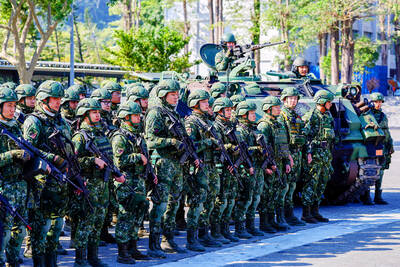Premier William Lai’s (賴清德) report on the government’s flood response measures has been delivered to the Legislative Yuan, with the report specifying five causes of flooding, including flood prevention infrastructure that is unable to handle extremely heavy rainfall.
Lai is scheduled to make an oral report at the Legislative Yuan on Tuesday and answer legislators’ questions about government efforts and flood response measures, with a focus on the flooding in southern Taiwan that was caused by a tropical depression last month.
With the increasing threat of extreme weather, the nation is seeing more “short-duration heavy rainfall” and “long-duration rainfall,” which has significantly increased the chance of flooding, the report said.
In the report, Lai highlighted five causes of flooding in Taiwan.
First, when larger-than-expected rains hit narrow river sections that are insufficiently dredged or have insufficient drainage systems, flooding can result, the report said, adding that flooding caused by these factors is aggravated in low-lying areas.
Second, the water levels of rivers are often much higher than their tributaries at the confluences, which slows the movement of water, causing rivers to breach their banks.
Third, every piece of flood prevention infrastructure is built to a certain standard: Facilities along rivers managed by the Water Resources Agency are designed to deal with precipitation with a recurrence interval of 100 years; drainage systems along rivers managed by local governments are built to handle precipitation with a recurrence interval of 10 years; and roadside trenches are created to handle precipitation with a recurrence interval of two to five years.
Flooding will occur when precipitation overloads flood these prevention facilities, the report said.
Fourth, as slopes have larger water catchment areas than level ground, and transfer water to level ground quickly, when rainfall is concentrated near the base of a mountain the likelihood of flooding is increased.
Fifth, lowland water buildup and the storm surges that accompany typhoons can affect drainage systems, hampering their performance and making flooding more likely.
The flooding that started on Aug. 23 were caused by a tropical depression and a southwesterly flow following close on its heels, with the two weather systems hovering above Taiwan for a week, Lai said.
The Central Weather Bureau on the evening of Aug. 22 issued extremely heavy rain warnings for Kaohsiung and Pingtung County and a heavy rain warning for Chiayi County, but in the early hours of Aug. 23, the day the flooding occurred, increased the warnings for Kaohsiung and Pingtung to torrential rain and for Chiayi to extremely heavy rain.
The tropical depression resulted in more than 500mm of rain being recorded in 24 hours, which was comparable to the rainfall caused by Typhoon Morakot in 2009, but affected a larger area.
The situation was exacerbated by the high tides that are often seen in August, which obstructed estuaries, overloading local drainage systems, Lai said.
Flooding in low-lying areas or areas suffering from fishery-induced land subsidence could not be reduced by the traditional gravity drainage method and had to be drained by water pumps, he said.
Those factors contributed to the worse-than-expected flooding, the report said.

UNILATERAL MOVES: Officials have raised concerns that Beijing could try to exert economic control over Kinmen in a key development plan next year The Civil Aviation Administration (CAA) yesterday said that China has so far failed to provide any information about a new airport expected to open next year that is less than 10km from a Taiwanese airport, raising flight safety concerns. Xiamen Xiangan International Airport is only about 3km at its closest point from the islands in Kinmen County — the scene of on-off fighting during the Cold War — and construction work can be seen and heard clearly from the Taiwan side. In a written statement sent to Reuters, the CAA said that airports close to each other need detailed advanced

Tropical Storm Fung-Wong would likely strengthen into a typhoon later today as it continues moving westward across the Pacific before heading in Taiwan’s direction next week, the Central Weather Administration (CWA) said. As of 8am, Fung-Wong was about 2,190km east-southeast of Cape Oluanpi (鵝鑾鼻), Taiwan’s southernmost point, moving westward at 25kph and possibly accelerating to 31kph, CWA data showed. The tropical storm is currently over waters east of the Philippines and still far from Taiwan, CWA forecaster Tseng Chao-cheng (曾昭誠) said, adding that it could likely strengthen into a typhoon later in the day. It is forecast to reach the South China Sea

Almost a quarter of volunteer soldiers who signed up from 2021 to last year have sought early discharge, the Legislative Yuan’s Budget Center said in a report. The report said that 12,884 of 52,674 people who volunteered in the period had sought an early exit from the military, returning NT$895.96 million (US$28.86 million) to the government. In 2021, there was a 105.34 percent rise in the volunteer recruitment rate, but the number has steadily declined since then, missing recruitment targets, the Chinese-language United Daily News said, citing the report. In 2021, only 521 volunteers dropped out of the military, the report said, citing

WEATHER Typhoon forming: CWA A tropical depression is expected to form into a typhoon as early as today, the Central Weather Administration (CWA) said yesterday, adding that the storm’s path remains uncertain. Before the weekend, it would move toward the Philippines, the agency said. Some time around Monday next week, it might reach a turning point, either veering north toward waters east of Taiwan or continuing westward across the Philippines, the CWA said. Meanwhile, the eye of Typhoon Kalmaegi was 1,310km south-southeast of Oluanpi (鵝鑾鼻), Taiwan’s southernmost point, as of 2am yesterday, it said. The storm is forecast to move through central